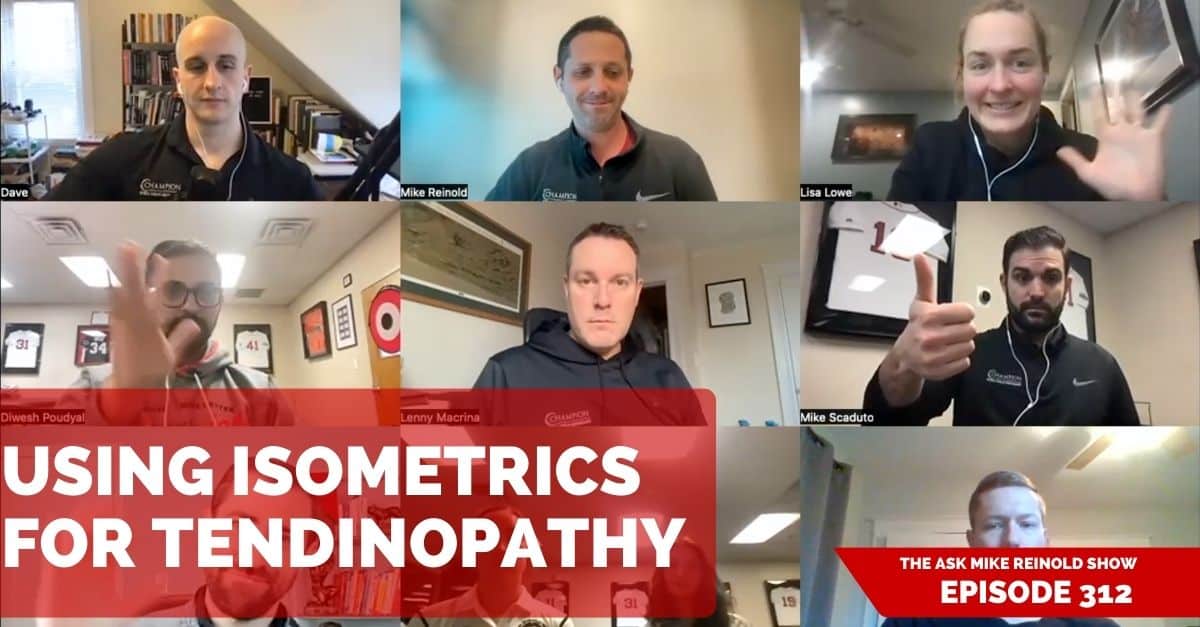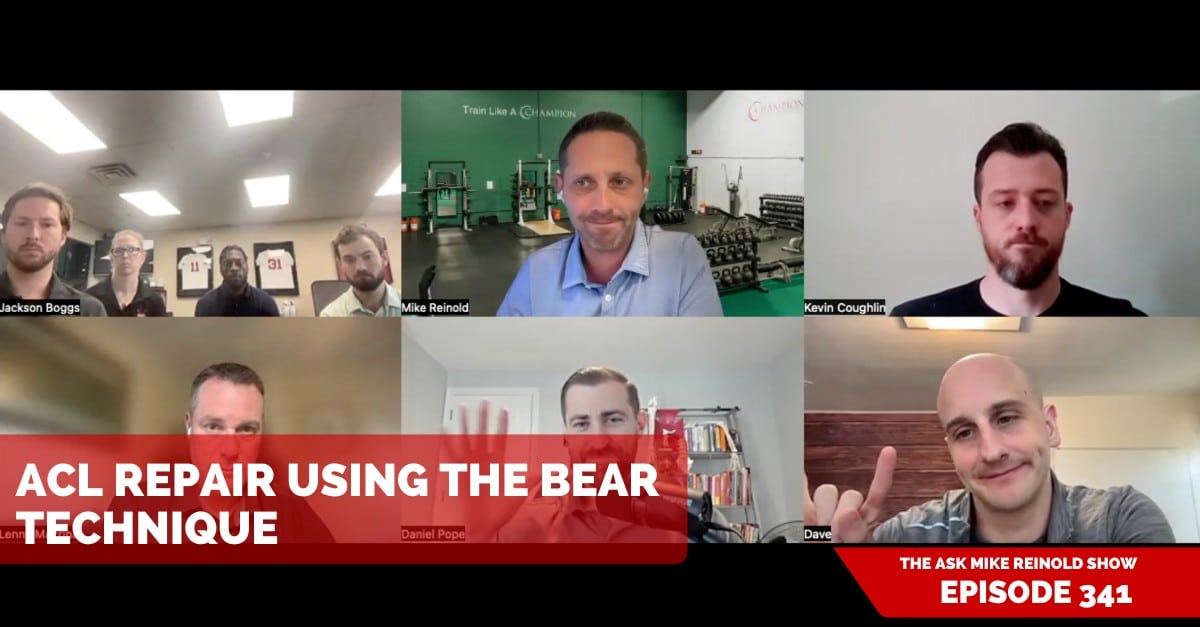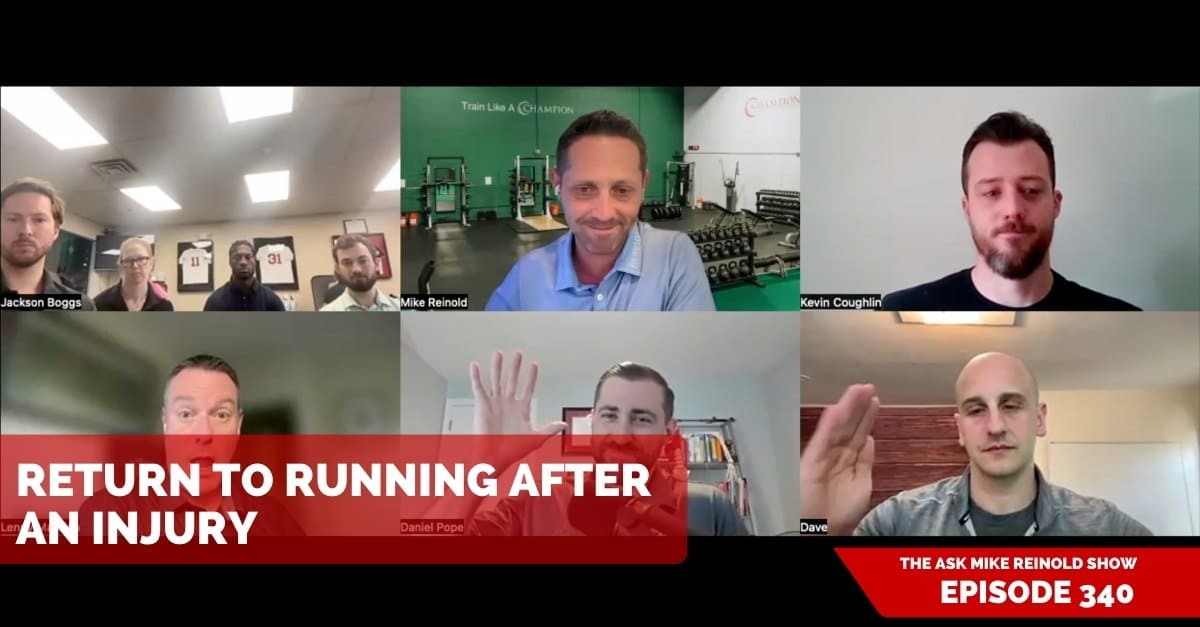Isometrics can be an important part of a treatment program designed for tendinopathies, helping reduce pain and return to activity. But many people seem to be overly reliant on them.
In this podcast, we talk about what we know about the use of isometrics for tendinopathies and how they can fit into a well-designed rehabilitation program using other types of contracts as well.
To view more episodes, subscribe, and ask your questions, go to mikereinold.com/askmikereinold.
#AskMikeReinold Episode 312: Using Isometrics for Tendinopathy
Listen and Subscribe to Podcast
You can use the player below to listen to the podcast or subscribe. If you are enjoying the podcast, PLEASE click here to leave us a review in iTunes, it will really mean a lot to us. THANKS!
Show Notes
• Managing Athletes with Patellar Tendinopathy
• Treating Acute Achilles Tendonitis
• How to Progress Loading Strategies After an Injury
Transcript
Nancy Kune:
All right, so we have Dan from Georgia. “I’m seeing a lot of people recommend isometrics for people with tendinopathies like patellar and Achilles tendinopathy. What makes isometrics a better option than just heavy loading?”
Mike Reinold:
Nice. Good job, Nancy.
Lenny Macrina:
Did Pope submit this question?
Dave Tilley:
I like how Nancy, you said Dan from Georgia as if she was Dan from Georgia with a Southern twang.
Mike Reinold:
Right. But then stopped.
Dave Tilley:
Dan from Georgia.
Lenny Macrina:
Dan from Georgia.
Mike Reinold:
At first I was was like, “Wow, she’s going to read the whole question with the Southern accent,” but then she…
Dave Tilley:
Hey, y’all. I’m seeing a lot of people with Achilles tendinopathy.
Lenny Macrina:
Virginia, Nancy.
Mike Reinold:
All right.
Dave Tilley:
The wheels are falling off.
Mike Reinold:
This is a terrible episode. I apologize to the listeners. So we’re going to hit this one strong because we started so poorly. But Dan, I like this question because I actually, I’m seeing this a lot. We’re seeing this a lot in the baseball world with the shoulder too, where people are like, “Oh, isometrics,” as if an isometric is a new concept there. This is a big deal.
But tell us a little bit about this, Dan, because I do think there’s some confusion on the internet. You could find a study that shows anything, and I know there’s some studies that show isometrics are helpful for tendinopathy, but I feel like in isolation, that’s almost a one-sided discussion. So Dan, you want to start with this one? Because I feel like I’ve seen you talk about this recently online, but tell me a little bit about isometrics for tendinopathy in general and what your thoughts are here.
Dan Pope:
Yeah, for sure. I think this is pretty confusing, especially for new grads coming out because there’s all these studies coming out about tendinopathy and it’s almost like people just use the treatment that’s most hot at the time. I think most of this research was popularized by Ebonie Rio.
So the original research that people are most familiar with is probably in the patellar tendon. So essentially what she was looking at was an isometric contraction versus isotonics. So regular knee extensions versus an isometric, which one was best for cortical inhibition and also pain reductions. And this was in the short term. So they were looking, I think initially like 45 minutes afterward, to see if those reductions in pain stuck around. And they were really strong. They reduced their pain by six to seven on a zero to 10 scale on a VAS, and they also reduced cortical inhibition better than the isotonics.
And then we tried to reproduce this in other studies in other areas too like the Achilles tendon. Ebonie Rio did this research in the Achilles tendon and she found similar results. Other people did not, meaning that the isotonics were just as good as isometrics. So generally speaking, the isometrics were really helpful for reducing pain. Isotonics were a little less good at reducing pain. And then future research was a little bit mixed.
I think the really important thing to keep in mind is that this research resulted in acute changes in pain. It’s not long-term and the same folks that are doing this research in isometrics are not saying to use isometrics for long-term pain relief. They’re saying use other forms, like eccentrics, heavy, slow loads. So generally speaking, isometrics can be helpful for reducing pain for your athletes or whoever you’re dealing with, but it’s not really the long-term outcome that’s supported in the literature.
And the other part is that thinking from a specificity perspective. Isometrics are not always going to be the best for getting your athletes back to sport. And they’re probably really useful in the short term, not necessarily long-term. So I just think it’s important that folks don’t use only isometrics when they’re writing a complete rehab program, and it’s not the only tool, and they’re powerful maybe for some folks, but only for short-term relief mostly.
Mike Reinold:
I like that though. I think you brought up a really good point though here too, because I think if you look at the evolution of some of these studies, and I may be slightly off with this, but it’s almost like some studies were published that showed isometrics were really good at tendinopathy. Like, “Oh, awesome, great.” Then there were some studies that showed eccentrics are great with tendinopathy. Like, “Oh, that’s great, that’s amazing.” Then studies come out, well, just heavy loading is good for tendinopathy. Like, “Oh great, that’s amazing.”
And we’ve evolved over time. I think to me, it’s the part that got me at the beginning with the isometrics. When you’re doing an isometric, when we do a post-op, right, it’s like 10, 20% of a max contraction. You’re just doing it to get the muscles to fire. But if you’re doing it at a max contraction, I mean that’s actually, that’s a lot of effort. That’s actually pretty good.
So if you do a study that compares basic isotonic exercises like straight leg raises and gentle ankle weight exercises with an aggressive isometric, I think there’s a big difference. So for me, I thought it was really cool to start to see the literature going towards the heavy loading concept that it’s more about that loading.
So I like that, but I like how you brought up the concept with pain because if there is a benefit, I think that would be a really neat one. So hit on that one real quick again for me, Dan, because I want to reemphasize that a little bit. But what was the specific protocol for that? So how do you use isometrics if you want to decrease pain in a tendinopathy? What’s the method?
Dan Pope:
Yeah, so I think it’s a little challenging to reproduce in a clinic, right? Because they’re looking at MVIC. It’s not like you can just throw electrodes on every single person in the clinic and figure out how hard they’re supposed to push. So it was 70% of someone’s max MVIC, and I believe the knee was at 60 degrees of knee flexion, pushing against an isometric load, five sets of 40, I think it was 45 seconds, 40 to 45 seconds, 70%.
So obviously you can kind of load up a super heavy isometric maybe on a knee extension machine, or I will even just do that against a wall. So basically sit against the wall and push against the wall, toe against the wall and just push. I tell people 70% of your max for 40 seconds, five sets. We do that prior to exercising.
A couple thoughts here. So we know you don’t have to reduce all of your pain in order to train. So from a physical therapy perspective, I use the pain monitoring system a lot. So basically speaking, if your pain isn’t above about a five out of 10, next day you’re back to baseline, the pain’s not that important. So if you want to use isometrics to reduce pain, great, but working through a little bit of pain isn’t necessarily a bad thing.
What I’ll do with my patients is I’ll try isometrics and if they’re working great and they’re gaining a great benefit from it and they feel they can do a lot more during the session, then I think that’s a big win. And the same thing goes for a sport. If you have an athlete that’s having a hard time competing, let’s say a basketball player, volleyball player with patella tendinopathy, you do the isometrics, they feel great when they’re playing.
Awesome, that’s amazing. But you don’t necessarily need it. It’s not like you need to start with your isometrics all the time, but it’d actually be very valuable in that patient that’s having a hard time doing functional activities because they have so much pain. So you start them with some isometrics and if it works well, then you go from there. Just keep in mind that isotonics also work well too. So I’ll even try things like sissy squats, reverse sled drags, that type of thing. Patellar tendinopathy, prior to exercising, because that is also very helpful to warm up the tendon. Tendons generally have a warm effect.
So I think they’re really useful in folks prior to exercising, but you may have someone who’s beyond that point, and you only have so much time in a given PT session, and sometimes we skip it because they don’t need it. They’re feeling pretty good, their pain levels are minimal and the pain’s not altering the way they move. So I think it’s a judgment called based on the PT and what they need, but it can be a valuable tool, but it’s just that it’s just, Len loves this term, but it’s another tool in your toolbox. You know what I mean?
Mike Reinold:
Again, great stuff, Dan. I mean, I think that concept is something that people don’t understand. 70% max effort for 45 seconds is a ton. That’s a lot. That’s a big contraction. So I think people need to understand that a little bit. And I’ve seen this applied poorly in lots of ways. I’ve seen people with chronic patellar tendinopathy and they’re doing sissy squad holds every day and they’re like, “Yeah, no, it seems like it’s getting worse.” I’m like, “Yeah, yeah, maybe. Maybe it’s because of what you’re doing.” So I’ve seen people almost apply this wrong, you know what I mean? Or I don’t know, in a different fashion, but I don’t know. Have you seen that?
Dan Pope:
Well, I just want to jump in real quick. This is funny because I kind of experienced this myself. So I think it was 2015 when the study came out initially and I was hot on it. It was like, “Oh great, I could apply this to every tendon.” And I had some really bad Achilles tendinopathy. It just flared up. I’m like, “All right, let’s try some isometrics.” And it just flared my Achilles tendon up so much.
And there was a follow-up study, it was a similar protocol with a calf raise for Achilles tendinopathy. And it was like majority of people got worse with the isometrics. And it was kind of cool because the study had a scatter plot of folks that did the isometrics. And it was interesting to see because they had a whole bunch of people did extremely well and a whole bunch of people did a lot worse afterwards.
And at least in my mind I’m like, “Okay, we’re reading research, we’re looking at the averages.” So generally speaking, some folks are going to do phenomenal with this and some folks aren’t. So you just give it a shot and then if it does find some effect, great, just keep in mind you’re looking for that short-term effect. So if it’s not giving you that short-term effect, then why use it?
Mike Reinold:
Right. I like it. Dave, what do you think?
Dave Tilley:
Yeah, I just want to jump in because we’re actually studying a lot of these links between… In gymnastics, there’s a lot of Achilles ruptures in gymnastics. And so me and my research partners are kind of reverse engineering some advice from Joe Cook, which is healthy tendons don’t tear, so that we’re looking a lot at maybe there’s a predisposer when they’re younger on tendinopathies.
And I think the really important point here that people have to remember is that we study textbooks and anatomy of things in one plane, but tendons in particular have to take a lot of 3D stress. And so I think when we do something and we look at an exercise like the Achilles for example, yes, there’s a lot of obviously dorsiflexion when someone’s backpedaling or running, which is where a lot of these are jumping and landing. But we also have to remember that it’s not only that straight sagittal plane. There’s a lot of rear foot eversion, for example, and tibial pronation, which causes medial tendon overload in an Achilles.
So a lot of that shearing stress starts to get really, really pronounced with deeper angles of a joint. So a knee, for example, in a really deep knee bend, there’s a lot of shearing stress on the patellar tendon. And on an Achilles, when you’re backpedaling or jumping and landing or running, there’s a lot of rotational and shearing stress. And we think that maybe that overloads in the medial tendon causes a tendinopathy and they get older and things kind of come together. And then maybe it’s the medial tendon that’s actually tearing.
So when you give someone isometrics, you’re controlling a lot of the degrees of freedom in certain planes. You’re not really having someone go super deep like an insertional tendinopathy versus a mid substance. It’s a similar phenomenon that maybe somebody can’t tolerate a really deep joint angle and just doing a mid-neutral planar isometric, or like Dan was saying, at a certain degree of 60 degrees or whatever.
Maybe by controlling some of the angle, it just makes someone feel better. And so there’s a mechanical idea, but also maybe someone’s just activating their tendon and their quad and loading in a ton, and it’s the first time it hasn’t been raging amounts of pain, so maybe that’s more like a pain science layer, but I think a lot of those studies kind of look at the overlap. What can we control as an entry point to load?
Mike Reinold:
Love it. Yeah, I think that’s a great way of thinking of it right there, and a great way of thinking about tendinopathy in general. So I wish it were as simple as just performing one quick exercise, and that’s the easy way out of everything. But to me it’s all about layering everything in to a comprehensive program that makes sure that we’re doing all this. All planes in motion, depths of the tendon, like Dave said, putting it all together with heavy load, eccentric load, plyometric load. There’s so much that needs to go into this.
So isometrics are a tool. Don’t get caught up thinking that isometrics are the end all be all, and they’re a very helpful adjunct to things that we can do if you use it appropriately, so great stuff. Thanks, Dan. Appreciate that question. If you have a question like that, head to mikereinold.com, click on the podcast link and you can type in your question in our little form. And we’ll keep doing these as much as you guys keep asking questions, so thanks so much. Head to Apple podcasts, Spotify, and be sure to subscribe and we’ll see you in the next episode. Thank you.





